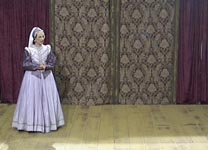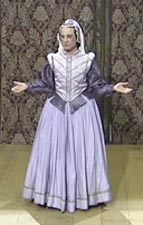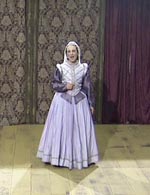-
Edition:
 King Leir
King Leir
King Leir
- Introduction
- Texts of this edition
- Contextual materials
81King Leir, Scene 11
Cast
Ragan: Derek Genova
Queen's Men Dramaturgy: Narrative Over-Determination (Sc.11)
82Read about narrative over-determination in Scene 10 [[ edition links should not have query or fragment parts ]]
Here, another soliloquy is inserted between scenes to set up subsequent action and provides another example of narrative over-determination. Ragan's joyful mood provides an instant contrast with the proceeding scene and her determination to send her father "packing" (![]() TLN 941) removes any element of surprise surrounding the action to come. The expectations raised are clear. Leir will arrive and be as sorely abused by Ragan as he was by Gonorill. The dramaturgy generates anticipatory fear for anyone empathizing with Leir but also makes the development of the plot predictable. In performance, the archness of our wicked sisters suggested another possible function of this dramaturgical strategy. The affect has something in common with the "He's Behind You!" gag from British pantomime. The lead actor stands on stage and asks the audience to let him know if they see the villain, who promptly appears upstage and creeps towards the hero. The mistreatment that is heading towards Leir is made so obvious that it took on qualities of this routine. Once again, the play proved far more playful than we first imagined, coming to it as we did, under the shadow of King Lear. The company developed a naive clown-like quality for the performances that served this aspect of the plays very well and became one of the defining aspects of the SQM style.
TLN 941) removes any element of surprise surrounding the action to come. The expectations raised are clear. Leir will arrive and be as sorely abused by Ragan as he was by Gonorill. The dramaturgy generates anticipatory fear for anyone empathizing with Leir but also makes the development of the plot predictable. In performance, the archness of our wicked sisters suggested another possible function of this dramaturgical strategy. The affect has something in common with the "He's Behind You!" gag from British pantomime. The lead actor stands on stage and asks the audience to let him know if they see the villain, who promptly appears upstage and creeps towards the hero. The mistreatment that is heading towards Leir is made so obvious that it took on qualities of this routine. Once again, the play proved far more playful than we first imagined, coming to it as we did, under the shadow of King Lear. The company developed a naive clown-like quality for the performances that served this aspect of the plays very well and became one of the defining aspects of the SQM style.
Read more about narrative over-determination [[ edition links should not have query or fragment parts ]]
Watch video of Scene 11 on the Performing the Queen's Men website. (The video footage is password protected. Click on "Cancel" in the pop-up window to obtain password.)
The Qeen's Men and Shakespeare (Sc. 11)
83Read about the Queen's Men and Shakespeare in Scene 1 [[ edition links should not have query or fragment parts ]]
Shakespeare's manipulation of expectation in King Lear is more complex and may well have been playing on residual expectations in his audience arising from memory of the Queen's Men play. Shakespeare's audience is led to believe that Cordelia was coming to save her father only to be surprised when the French army loses and Cordelia is imprisoned. The martial Edgar then becomes the hope of salvation and carries the hope of divine justice on his sword but although he defeats Edmund in single combat, his effort comes to late to save Cordelia and the King. The Queen's Men's dramaturgy confirms the power of God's Providence; Shakespeare raises comparable expectations only to disappoint the very expectations he raises. The Queen's Men's play falls steadily in line with protestant ideology thus serving the political mandate of the company as conceived by Walsingham and Leicester, according to McMillin and MacLean. With the playful quality developed by the company the happy outcome was never really in doubt in performance.
Performing Ragan (Sc. 11)
84Read about performing Ragan in Scene 2 [[ edition links should not have query or fragment parts ]]
The play goes out of its way to show that both Ragan and Gonorill dominate their husbands. The SQM actors playing Ragan and Gonorill took great relish in manipulating Cornwall and Cambria. In a modern context their empowerment was not controversial or threatening. The audience enjoyed the characters and laughed at their obvious manipulation of their husbands. Watching the performances, however, and imagining the same scenes performed in their original context, I wondered how they would have been received. From a traditional, patriarchal perspective, the queens' behavior would have been defined as an inversion of "natural" order (https://internetshakespeare.uvic.ca/Library/SLT/ideas/order/sexes.html). Transgressive women were perennially popular figures in early drama - the Noah's wife characters from Flood plays of York, Wakefield and Chester are pertinent examples. The audience likely still laughed, but would part of that laughter have been scorn directed at the ignorant husbands? Would the laughter have been enhanced by the element of transgression in their behavior?
85The company's performances of gender clearly engaged with the complex, contemporary discourse generated in part by the presence of their patron, the female ruler of the country. While in matters of religion and political authority their position is crystal clear, in matters of gender their message is more difficult to define. The good Cordella is presented in juxtaposition to her wicked sisters, but she too resists male authority and her refusal to obey Leir in matters of marriage is depicted in a positive light. I suspect that the humor surrounding the wicked queens that proved still to be enjoyable today might have had a more contentious edge in the original performances.
Read more about performing Ragan [[ edition links should not have query or fragment parts ]]
Visit the Performing the Queen's Men website to explore the issue of gender in the SQM performances.
Watch video of Scene 11 on the Performing the Queen's Men website. (The video footage is password protected. Click on "Cancel" in the pop-up window to obtain password.)



